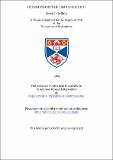Hydrodynamics of liquid helium II
Abstract
Observations have been made of the behaviour of a fine quartz fibre, weighted at its lower end and suspended inside a short, horizontal tunnel in which counterblow of the normal and superfluid components of liquid helium II can be produced by a heater. Section I of this thesis is an introduction to the hydrodynamic of liquid helium II. In section II the interaction with such a fibre of quantized vortex lines in the superfluid is discussed, and the effect of a short heat pulse on the fibre when it is carrying superfluid circulation in calculated approximately. The different responses of the fibre to turbulence in the normal fluid and in the superfluid are contrasted.
In section III, after a description of the apparatus and the experimental method, measurements, deduced from the response to heat pulses, of the circulation about the fibre from 1.3°K to2.1°K are reported. At all temperatures circulations of the expected order from magnitude are observed to grow and decay with time. At 1.3°K apparent circulations of up to about 1/5 quantum occur. In undisturbed helium the largest circulations are more stable than other values, persisting for up to five minutes. Measurement of the same circulation both by the heat-pulse method and by the deflection of the fibre in a steady heat current suggests that the large, persistent circulations may in fact be equal to one quantum. The sense of the observed circulations about the fibre at 1.3°K is strongly biased, this bias being probably associated with the heater geometry. In small heat current no change in the bins or persistence of circulation can be detected, but in currents above 11/2-3 mW/cm², depending on the heater, the circulation about the fibre is both more variable and of the opposite bias to that in undisturbed helium. This behaviour continues for 100 sec or more after the heat current has been switched off. At higher temperatures there are indications that the behaviour might be similar if it were possible for the helium to region its undisturbed condition after being stirred up by turbulent heat currents. In fact this seems other to be impossible, or to require many hundreds of seconds, and the situation is therefore rather confused.
In still higher heat currents measurement of superfluid circulation by heat pulses is impossible because the fibre is continuously agitated in a random way. From measurements of the rms deflections of the bob on the end of the fibre a critical heat current for the onset of such turbulence is found at 1.3°K. At higher temperatures the sensitivity is too low for the transition itself, if any, to be detected, but an upper limit to the critical heat current is given. At 1.3°K and 2.1°K the rms deflection increases monotonically with increasing heat currents, but at intermediate temperatures it is variable, because the bob is often hardly agitated for long periods during apparently supercritical heat currents. This is called quiescent behaviour.
When a supercritical heat current is a delay before agitation of the fibre begins. The delay time, which is often not very well defined, has been measured as a function of the heat current. When the current is switched off the agitation of the bob decoys in a few seconds, but at 1.3°K the circulation about the fibre is small and variable for 100 sec or more, until the persistence and bias characteristic of undisturbed helium regained. These results are discussed in section IV.
Type
Thesis, PhD Doctor of Philosophy
Collections
Items in the St Andrews Research Repository are protected by copyright, with all rights reserved, unless otherwise indicated.

